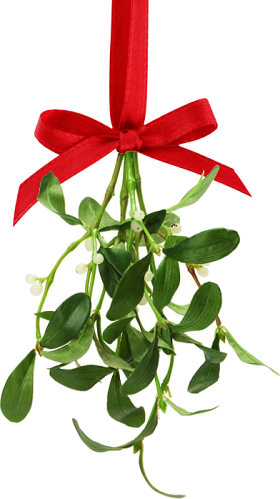 Christmas Traditions »
Christmas Traditions »
The History of Mistletoe
A popular Christmas tradition in modern times is kissing under the mistletoe. A sprig of the plant is hung, and those who stand beneath it invite a kiss. How did this plant's association with Christmas and kissing come to be?
Mistletoe, whose botanical name is Viscum Album, is a parasitic plant which grows amongst the branches of trees and shrubs. It is an evergreen featuring small, yellowish flowers and white berries. Druid priests held the plant sacred and used it in their winter celebrations 200 years before the birth of Christ. The plant was revered since it remained green year long – even through cold, harsh winters – despite the fact that it is not rooted in soil. It was seen as a symbol of fertility and used as a medicinal cure for various ills.
Other ancient cultures also attributed mystical powers to the plant. Celtics believed mistletoe to have magical healing powers and used it as an antidote for poison, infertility, and to ward off evil spirits. Among Romans, the plant was viewed as a symbol of peace and friendship. According to legend, enemies who met under mistletoe would lay down their weapons and embrace.
The custom of kissing under the mistletoe may have sprung from Norse mythology and the story of Frigg, Norse goddess of love and fertility, patron of marriage, and wife of Odin. When Frigg's son Baldr dreams of his impending death, she exacts an oath from all things in creation to do no harm her beloved son. But Frigg fails to ask this promise of the young mistletoe plant, and Baldr is killed by an enemy's arrow made of mistletoe.
In one version of the legend, to ease her grief Frigg proclaims mistletoe the symbol of love so it may cause no more harm. In a happier telling of the story, Frigg weeps over the body of her son Baldr, and as her tears drop upon the mistletoe arrow, they are transformed to small, white berries. Baldr is miraculously brought back to life and Frigg vows that anyone standing beneath mistletoe will come to no harm, but instead receive a token of love... a kiss.
Mistletoe was the magical ingredient in the kissing ball or kissing bough in Victorian England. Made of a round frame trimmed with ribbons and ornaments and often holding a tiny nativity, mistletoe was affixed to the bottom and the ball was the hung from rafters or the ceiling. Guests at holiday parties, weddings and other festive occasions then played kissing games beneath the ball and a kiss beneath the decoration was said to bring good luck and lasting friendship.
Washington Irving (1783-1859), American author, notes another tradition in kissing beneath the mistletoe in Old Christmas From the Sketch Book of Washington Irving:
"The mistletoe is still hung up in farm-houses and kitchens at Christmas; and the young men have the privilege of kissing the girls under it, plucking each time a berry from the bush. When the berries are all plucked, the privilege ceases."
It seems that the custom of plucking berries for each kiss, and ceasing the bestowal of kisses once the berries are gone, has been left behind.
Still, the hanging of mistletoe and the custom kissing beneath it remains a popular tradition in Christmas celebrations.
© Deborah Whipp







